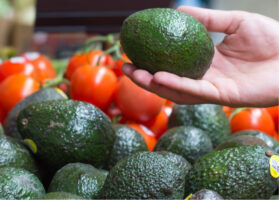The export industry berries from Mexico has had a very good start to the campaign, as the Thanksgiving holidays in the United States boosted sales, with an increase of between 5 and 6% for exports of blueberries, raspberries, strawberries and blackberries. An increase in sales at Christmas is also expected in the markets of the United States, Europe and the Far East, according to engineer José Luis Bustamante, president of the National Association of Berry Exporters of Mexico (Aneberries).
The export of early “berries” from Mexico grows 6% thanks to Thanksgiving sales in the US.
Overview of berries from Mexico in the U.S. market, complemented by charts from Agronometrics. Original published on December 12, 2022.
“Our Mexican season began in August 2022 and will end in July 2023. Right now, at the start of the export season for Thanksgiving, which is a very important day for Mexican agricultural products that are exported to the United States, in special the berries, we have done well. We exported 4.500 tons of raspberries during Thanksgiving week, an increase compared to previous years that is 5-6% above previous seasons for all of the berries. The strawberry export season has just started. We export a little in October, but during November and December and again between January and March, we have higher volumes, and that is our export window. Volumes are lower in the US market due to weather conditions in California and Florida. Consequently, sales prices rise and the situation appears positive for the berries mexicans. We had a promising start, we have enough fruit in Mexico to cover our orders. In the case of strawberries, 98% was sent to our main markets, the US and Canada,” explains Bustamante.
Blueberries
As for blueberries, Bustamante says that they are moving away from the fall window in the US due to the abundant supply from Peru on those dates. “We are delaying production, our goal is to start in December, and we are looking for the peak of the season to fall in March and April. Our goal is to supply the market 52 weeks of the year. The blueberry shows a growing demand. Right now, we see the market continue to grow, but perhaps not as fast as before. We also send a large component of our blueberry exports to the Far East and a bit to the Middle East. We supplement US production, we can ship during the winter months. The Far East is a very good market that is attractive to Mexican growers, especially since blueberries are the only berry able to endure the long journey there. We are convinced that blueberries have a great opportunity in the Far East.

Source: USDA Market News via Agronometrics.
(Agronometrics users can view this chart with live updates here)
Raspberries
Bustamante says that they intend to grow raspberries year-round in Mexico, a country that has become the world’s second largest exporter of raspberries after Russia. “We are in a very interesting situation because it requires a lot of labor, especially during the harvest. Technological advances have been made that allow us to grow crops in Mexico almost all year round. It has also increased the opportunity to ship product throughout the year. There is great potential that we can grow along with the good demand in the US Our goal is not just to sell the volume, but also to do it in a way that the market can absorb it. We also export our raspberries and blackberries to Europe, but North America is still the biggest market.”

Source: USDA Market News via Agronometrics.
(Agronometrics users can view this chart with live updates here)
Strawberries
According to Bustamante, strawberry prices in Mexico’s domestic market can sometimes reach higher levels than those of exports. «During the months of November and December, the export market is higher. The Christmas season is very good for our berries, as demand and prices increase, which helps to offset costs that do not stop rising. For us, it is a good time. Strawberries sell especially well during Christmas and Valentine’s Day, not to mention Mother’s Day and Easter, which is right outside our window,” he details.

Source: USDA Market News via Agronometrics.
(Agronometrics users can view this chart with live updates here)
Increased cost of inputs
Bustamante says that the Mexican sector of the berry It also notes the effects of the increase in the costs of inputs, which reduces the profitability of producers. “We also have higher input costs. Inflation is putting pressure on our producers. Being a specialty crop, we have to buy plastic for the tunnels, and its price has increased. Steel prices are also increasing and that puts pressure on new production fields. Fortunately, in Mexico we can produce nitrogen fertilizers, although we have to import a lot of fertilizers from abroad. Shipping and logistics limit exports to faraway countries, so it’s good to be close to the US.”
Temporary labor
“As far as labor is concerned, we also predict that having immigrant workers in Mexico will become more important. Most of the producers come from the communities in which the berries. As production grows, we will need more workers. We have to bring workers from southern Mexico to the center of the country, and once they’re done, they leave in May of each year to pick grapes in Sonora, and then they also pick asparagus near the border,” concludes Bustamante.
The News in Charts is a collection of stories from the industry complemented by charts from Agronometrics to help better tell their story.
Access the original article with this (Link)






